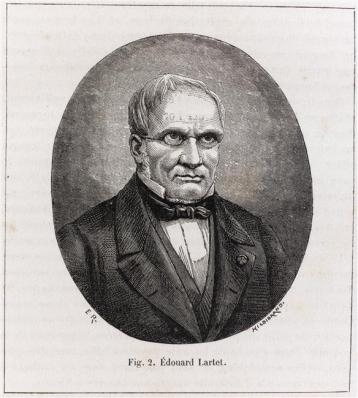
- Home
- Portrait gallery
- CTG members
- Édouard Lartet (1801-1871)
Using human fossils discovered in Aurignac (Haute-Garonne), geologist and prehistorian Édouard Lartet became the founder of human palaeontology. As such, today he is still considered to be one of the founding fathers of prehistory.
Taken from "La chasse à l'époque du Bronze" © MAN
Thanks to human fossils discovered in Aurignac (Haute-Garonne), geologist and prehistorian Édouard Lartet became the founder of human palaeontology. He was appointed a member of the Commission de Topographie des Gaules in August 1866.
One of the founding fathers of prehistory
In the 1830s, on one of his properties, Édouard Lartet identified more than 90 fossils of extinct animal species. Probably influenced by Boucher de Perthes, he used stratigraphy to help him establish the chronology of occupation of an area of land. In 1860, archaeological excavations that he carried out at Massat and Aurignac helped prove that man lived alongside extinct animal species. Soon after, he put forward a chronology of the Quaternary based on successive species of large dominant mammals, using which he believed he could date Palaeolithic lithic industries. His lecture before the Académie des sciences on 16 September 1859, in which he argued for man’s presence in very high antiquity, contributed to the recognition of prehistory.
In 1863, while carrying out excavations with the English collector Henry Christy on the major sites of Périgord, including Le Moustier, Laugerie-Basse and La Madeleine, he discovered engraved objects which proved the existence of prehistoric art. He was appointed professor of palaeontology at the Muséum d'Histoire naturelle in 1869.
One of the founding fathers of the musée gallo-romain
In 1865, on the instigation of Verchère de Reffye, Édouard Lartet was appointed a member of the consultative commission for the museum’s organisation. His participation, along with that of Gabriel de Mortillet, contributed to the highly educational presentation of room 1.


